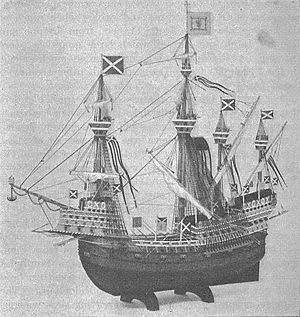Michael (ship)
 A model of Michael in the Royal Museum | |
| Career (Scotland) | |
|---|---|
| Name: | Michael |
| Builder: | Newhaven dock |
| Laid down: | 1507 |
| Launched: | 12 October 1511 |
| In service: | 18 February 1512 |
| General characteristics | |
| Tons burthen: | 1000 |
| Length: | 73.2 m (240 ft) |
| Beam: | 11 m (36 ft) |
| Propulsion: | Sails |
| Complement: | 1,420: 300 sailors, 120 gunners & 1000 marines |
| Armament: |
|
| Notes: |
|
Michael (later popularly known as Great Michael) was a carrack or great ship of the Royal Scottish Navy. She was too large to be built at any existing Scottish dockyard, so was built at the new dock at Newhaven, constructed in 1504 by order of King James IV of Scotland. She was ordered around 1505 and laid down in 1507 under the direction of Captain Sir Andrew Wood of Largo and the master shipwright Jacques Terrell, launched on 12 October 1511 and completed on 18 February 1512. When launched she was the largest warship in Europe, with twice the original displacement of her English contemporary Mary Rose which was launched in 1509 and completed in 1510.
The poet William Dunbar wrote of her construction:
- "Carpenters,
- Builders of barks and ballingars,
- Masons lying upon the land,
- And shipwrights hewing upon the strand."
The chronicler Lindsay of Pitscottie wrote of the building of Michael that "all the woods of Fife" went into her construction,(it has been suggested that by this period there was not much forestry left in Fife). Account books further add that timbers were purchased from other parts of Scotland as well as from France and the Baltic Sea. Supposedly there were many cargo loads of timber imported from Norway that were used in the construction of the Michael. Lindsay gives her dimensions as being 240 feet (73.2 m) long and 35 feet (11 m) abeam. Russell (1922) notes that Michael was supposed to have been built with 3.04 meter (10 feet) thick oak walls. She displaced about 1,000 tons, had four masts, carried 24 guns (purchased from Flanders) on the broadside, 1 basilisk forward and 2 aft and 30 smaller guns (later increased to 36 main guns), and had a crew of 300 sailors, 120 gunners, and up to 1,000 soldiers.
Michael's other curious claim to fame is that she is said to have carried among her armament Mons Meg, the great cannon used earlier in the siege of Threave Castle, which had a calibre of 22 inches and thus made her the warship with the largest calibre gun in history,[citation needed] even when the 20th century 40 cm/45 Type 94 naval guns of the World War II-era Japanese battleship Yamato and her sister ship, the Musashi, are considered.
Henry VIII of England was unwilling to be outdone, and ordered the building of the 1000-ton Henri Grâce à Dieu, launched in roughly 1512, later known as Great Harry. These ships were the first great ships, the precursors of the later ship of the line.
Michael was named after the archangel Michael and built with the intention of leading a crusade against the Ottoman Empire to reclaim Palestine for Christendom. This grandiose plan had to be changed when the commitments of the Auld Alliance with France required Scotland to go to war with England to divert England from her war with the Louis XII of France (see the Italian Wars).
In August 1513 a Scottish invasion force was assembled to attack English possessions in France. Commanded by James Hamilton, 1st Earl of Arran, the chief ships were Michael, Margaret and James. Instead of attacking the English, Arran raided Carrickfergus in Ireland and returned with the loot before proceeding to France.
A warship of this size was costly to maintain. Michael was hired by France in late August 1513, [citation needed] and after James IV and many of the nobility of Scotland were killed at the Battle of Flodden Field in September 1513, Michael was sold to Louis XII of France on 2 April 1514 for the cheap price of 40,000 livres and was known as "La Grande Nef d'Ecosse" (The Big Nave of Scotland; nave is from the medieval Latin navis, meaning "ship,"). Most historians have accepted the account of the Scottish historian George Buchanan that after this the French allowed her to rot at Brest. However recently one historian, Norman MacDougall, has suggested that it is worth investigating the possibility that, under her new French name, she took part in the French invasion of England in 1545 that led to the sinking of the English warship Mary Rose in the Battle of the Solent on 19 July 1545. [1]
References
- ↑ *Macdougall, Norman (1991). Scotland & War, Ad 79-1918. ISBN 0-85976-248-3. article James IV's Great Michael
- Russell, John (1922). The Story of Leith. http://www.electricscotland.com/history/leith/index.htm.
| ||||||||||||||
